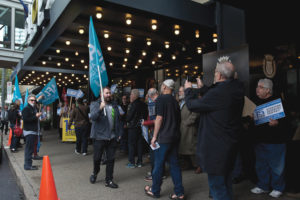Musicians of the Washington National Opera (WNO) and Kennedy Center Opera House orchestras, members of Local 161-710 (Washington, DC), have ratified one-year contracts with the two organizations. The agreements will run through August 31, 2018. Initially working toward longer-term contracts, it became clear that one-year agreements would yield more progressive outcomes.
WNO initially proposed a three-year agreement with a 10% reduction in work and no wage increases, while the Kennedy Center initially offered a three-year agreement with a work reduction of one week (14%) in the second and third years. Musicians’ salaries under the combined contracts will be just above $70,000 for the 2017-2018 season—a small increase. The orchestras’ librarians are now covered as bargaining unit members under the two CBAs. The Kennedy Center Opera House season is seven weeks long, while the WNO contract totals 342 hours, within a 21-week period.
“We hope that the additional year will give the opera some breathing room, so that the opera season cuts we conceded in previous agreements will turn out to be only temporary,” says Orchestra Committee Chair Peter de Boor of Local 161-710.















